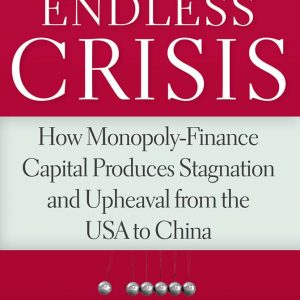Immiseration
John Bellamy Foster and Robert W McChesney, The Endless Crisis – How Monopoly-Finance Capital Produces Stagnation and Upheaval from the USA to China, Monthly Review Press, 2012, 240 pages, hardback ISBN 9781583673133, £18.95
John Daniels
This is another book from the Monthly Review stable defending and extending the theoretical work of Baran and Sweezy, two redoubtable Marxist economists who along with Harry Magdoff kept the flame of Marxist economics alive in the United States through some pretty arduous domestic and international times. Readers may recall another title reviewed in Spokesman 111, The Great Financial Crisis: Causes and Consequences, in which the idea of capitalist stagnation was explained with particular reference to the present crisis. This new book takes on the task of defending and extending the same thesis on a broader theoretical basis, with additional material including substantial pieces on the international division of labour and China’s political economy.
Overarching The Endless Crisis is the idea that what we are enduring globally is the high point of economic crisis, and that this crisis is a direct response to the long-term stagnation that has beset capitalism since the early 20th century. Whether it is bubble or bust, stagnation is the normal state of the world economy. Few of us would want to recall the placid ‘normalcy’ aspired to by Warren G. Harding’s slogan in his 1920 presidential campaign, which was to be followed in a few years by the Wall Street Crash and the onset of world depression and war. Perhaps more apt for our times are the words of the singer Bruce Cockburn, quoted in the preface, ‘the trouble with normal is it always gets worse’.
This assertion is amply explained in the first chapter where the relationship between economic stagnation and the proneness of monopoly-finance capital to bubbles and crises is demonstrated. The authors note that ‘at least fifteen major episodes of financial disruption have occurred since 1970’. The existing form of capitalism, which according to the authors can be described as one of ‘monopoly-finance capital’, stems from a previous incarnation, namely that of monopoly capitalism, so effectively described and analysed by Baran and Sweezy. The authors maintain that stagnation is a consequence of over-production and under-consumption and that the failure to find sufficient opportunities for capital accumulation in productive industry has forced capital into speculative finance and indebtedness. Since the 1970s, a virtual wage freeze has been imposed on the workers, which again has forced up personal indebtedness and induced instability in the property market, amongst other harmful effects…

Comments are closed.